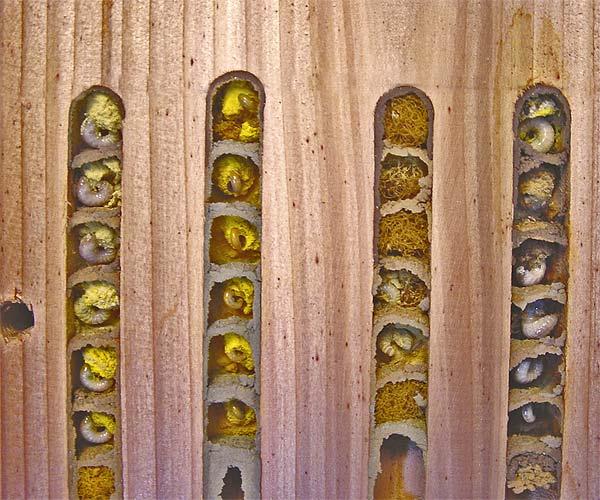Mason Bees and Bee Hotels
Patricia Jones
One of our native mason bee species, Osmia lignaria, the blue orchard bee. Photo by Brian Buckner
I have been asked a lot of questions the past couple of weeks about mason bees, and specifically mason bee hotels that you can put up in your yard. This coincides with an article about mason bees in Scientific American about the attempts of the almond industry to start commercially producing (and pollinating with) mason bees. The colony collapse disorder in honeybees has hit almond farmers particularly hard. This has led the industry to search for alternative pollinators, and the blue orchard bee, Osmia lignaria, emerged as a likely candidate. Mason bee is a general term usually referring to bees in the genus Osmia which use mud and clay in building their nests (thus the "mason" reference). Here in Maine we have 16 species of mason bee, only one of which, Osmia caerulescens, is non-native. They are often metallic green or blue like the blue orchard bee in the photo above, but are not to be confused with sweat bees which are also usually metallic but in a totally different family (Halictidae). Mason bees will sting if you squeeze them too hard, but the sting is very minor. Mason bees live in holes in wood the stems of reeds and are solitary, which is to say they do not have a single queen and lots of workers, rather each female lays her own eggs and provisions for them. They are however, fairly gregarious, with females laying their eggs in holes right next to other females. The photo below shows a cut-away bird's-eye-view of what the nests of individual females look like in a man-made mason bee home. A female will select a hole, and at the furthest point from the entrance she will put a ball of collected pollen, lay a single egg on that pollen ball, and then build a mud wall to close off that "cell". She will repeat this over and over until it fills up her hole like so:
Each cell therefore contains a mason bee larva feeding on the pollen ball its mother provided.
In Europe and Japan orchards are effectively using mason bee species for pollination of crops like plums, apples, and nuts. They are highly effective pollinators, with some reports of one mason bee female being able to pollinate as many flowers as 100 honeybees. This has to do with differences in their behavior. Mason bees visit more flowers than honeybees in each foraging visit, travel further between trees, and make more contact with the reproductive parts of the flowers than honeybees. The effort to commercial rear blue orchard bees for almond pollination is colossal, as detailed in the Scientific American article. But if you are interested in interacting with some mason bees in your own yard, it's pretty feasible. Mason bee "hotels" or "condos" have become popular recently. These are easy to make, and there are lots of places you can buy them. They do require some annual maintenance to keep pests under control.
Homemade mason bee house note that this kind is not great (see below)
Mason bee house for sale from gardening shops
The best mason bee houses have removable/replaceable tubes (often made out of reeds or cardboard). This is because pests, parasites and molds can build up in the houses, so you need to replace the reeds on an annual basis. Mason bees overwinter as cocoons and emerge as adults in the spring, so you would want to wait for the bees to emerge in the spring and then replace the wooden blocks or tubes. If you want to be more involved in management of mason bees you can actually remove the cocoons from the tubes in the fall, sort and clean them from infected cocoons, and overwinter them in your fridge (see lots of details on how to do this here). You are likely to get a mixture of native and non-native mason bee species, as well as some leafcutter bee species (Megachile sp):
Leafcutter bee. Photo by Kim Taylor
Leafcutters cut circular pieces out of plant leaves to line their nests. They are also good pollinators, and we have 11 native Megachile species in Maine and two non-natives. They may, however, leave your roses with circular holes in the leaves, but the roses will survive.




